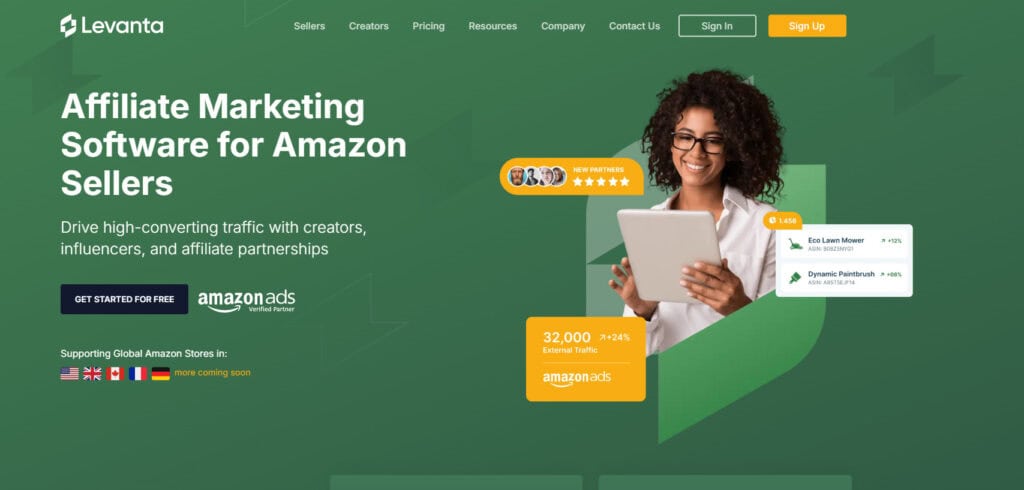- What Do Influencer Marketing Platforms Do?
- Find the Right Influencers Fast
- Stay Organized and Keep Track of Every Detail
- See What’s Working (and What’s Not) in Real Time
- Make Payments Simple (and Avoid Awkward Conversations)
- Review Content Before It Goes Live
- Track Sales With Affiliate Links and Discount Codes
- The Best Influencer Platforms for Different Needs
- 1. Best for Finding Influencers Quickly: Aspire
- 2. Best for Performance-Based Campaigns: Grin
- 3. Best for Small Businesses: Trend
- 4. Best for Amazon Sellers: Levanta
- 5. Best for Influencer-Driven Content Creation: Upfluence
- How to Choose the Right Influencer Marketing Platform
- Final thoughts
Last Updated on November 18, 2025 by Ewen Finser
I’ve been in the affiliate space for over a decade, working with influencers across our portfolio of different niches. While influencer marketing is one of the best ways to get your brand in front of the right audience, building trust, driving sales, and making your brand feel like a natural part of the conversation, it can come with a few challenges:
- Finding the right influencers who are actually ready to work with your brand
- Dealing with influencers who can be flaky, inconsistent, or not very strategic
- Struggling to connect with the right ones based on your niche and brand needs
- Managing expectations—some influencers overpromise and underdeliver
- Navigating pricing and negotiations, which can vary wildly and be hard to justify
- Tracking actual performance and ROI when results aren’t always transparent
- Using the right influencers for the right platform
That’s where influencer marketing platforms come in but how do you choose the right one?
With so many influencer marketing platforms out there, the real challenge isn’t just finding one—it’s finding one that actually solves these problems.
The right platform should make it easier to connect with reliable, strategic influencers, streamline communication, and provide the data you need to measure success. Some platforms focus solely on influencer discovery, others handle full campaign management, and some offer advanced tracking and reporting.
The key is choosing one that aligns with your goals and eliminates the guesswork. Let’s break it down and find the best fit for you.
What Do Influencer Marketing Platforms Do?
Running an influencer marketing campaign without the right tools is like planning a cross-country road trip with no GPS, no map, and no plan for gas stops. You’ll get somewhere eventually, but it’s going to be messy, frustrating, and full of unnecessary detours. That’s where influencer marketing platforms come in: they help you find the right influencers, manage collaborations, and track results without the guesswork.
Instead of spending hours scrolling through social media, sending cold DMs, and tracking everything in an endless maze of spreadsheets, these platforms streamline the entire process. They connect you with influencers who fit your brand, keep all your campaign details in one place, and give you real data to measure success.
Find the Right Influencers Fast

Imagine you run a small but growing coffee brand, and you want to partner with influencers who genuinely love coffee. You don’t want just anyone with a big following, you need someone whose audience actually cares about specialty coffee. Finding the right people manually means scrolling through Instagram or TikTok for hours, hoping to stumble across the right match.
Influencer marketing platforms make this much easier. You can search by niche (coffee lovers, food bloggers), location (major cities, international markets), engagement rate (so you don’t end up with someone who has thousands of ghost followers), and even audience demographics. Instead of blindly reaching out to influencers who may or may not be interested, you get a curated list of creators who already align with your brand.
Many platforms also provide performance insights, like average post engagement and past brand collaborations. This helps you avoid influencers who look great on the surface but don’t actually drive results.
Stay Organized and Keep Track of Every Detail
Working with one influencer is easy enough. But what happens when you’re managing ten at once? Suddenly, you’re drowning in email threads, tracking deadlines in a messy spreadsheet, and trying to remember who’s supposed to post what, when.
A good influencer marketing platform acts as your campaign control center. Instead of scrambling through emails and losing track of important details, you get a single dashboard where you can see all your influencer collaborations at a glance. You can track deadlines, store contracts, and manage ongoing conversations without jumping between apps.
For example, if you’re launching a new skincare line and collaborating with 15 beauty influencers, you can set up automated reminders for posting dates and approvals. No more frantically messaging influencers at the last minute, asking if their content is ready.
See What’s Working (and What’s Not) in Real Time
Let’s say you’re running an influencer campaign for a new fitness app. You’ve partnered with five influencers, and you’re eager to see the results. If you’re doing this manually, you’ll have to ask each influencer for screenshots of their analytics or try to piece things together from likes and comments. That’s not exactly a reliable way to measure success.
Influencer marketing platforms give you real-time performance data. You can track impressions, engagement rates, clicks, and conversions, all in one place. Maybe one influencer is driving a ton of sign-ups while another is barely getting any engagement. With clear data, you can adjust your approach, investing more in what’s working and tweaking or pausing what’s not.
Without this insight, you’re flying blind, hoping your campaign is effective but never really knowing.
Make Payments Simple (and Avoid Awkward Conversations)
If you’re managing payments manually, you’re probably dealing with scattered invoices, different payment methods, and the occasional “Hey, just checking in on that payment” message.
Influencer marketing platforms simplify this by offering built-in payment tools. You can set payment terms, automate transactions, and even manage international payments without extra headaches. If an influencer gets paid only after posting their content, the platform ensures that happens automatically, so you don’t have to keep track of it manually.
Review Content Before It Goes Live
Picture this: You’re launching a new product, and you’ve partnered with influencers to spread the word. The day of the launch, you see an influencer’s post—only to realize they misspelled your brand name and got the product details wrong. Now, thousands of people are seeing incorrect information, and there’s nothing you can do about it.
To prevent this, many influencer marketing platforms let you review content before it goes live. You can check captions, verify product descriptions, and ensure influencers are using the right messaging and hashtags. This keeps your brand image consistent and helps avoid mistakes that could hurt your campaign.
Track Sales With Affiliate Links and Discount Codes
If your goal is to drive sales, you need a way to track how many customers each influencer is bringing in. Many platforms allow you to generate unique affiliate links or discount codes for each influencer, so you can see exactly who’s driving the most revenue.
The Best Influencer Platforms for Different Needs
Finding the right influencer marketing platform can be a game-changer for your brand. Different platforms offer different features, so picking the one that fits your goals is key. Let’s take a closer look at some of the best options and what makes them stand out.
1. Best for Finding Influencers Quickly: Aspire
If you’re in a rush to find the right influencers, Aspire is one of the best tools out there. It has a huge database of influencers and lets you filter by niche, location, engagement rates, and even audience demographics. Whether you’re looking for influencers in the beauty space or fitness, Aspire helps you find them fast.
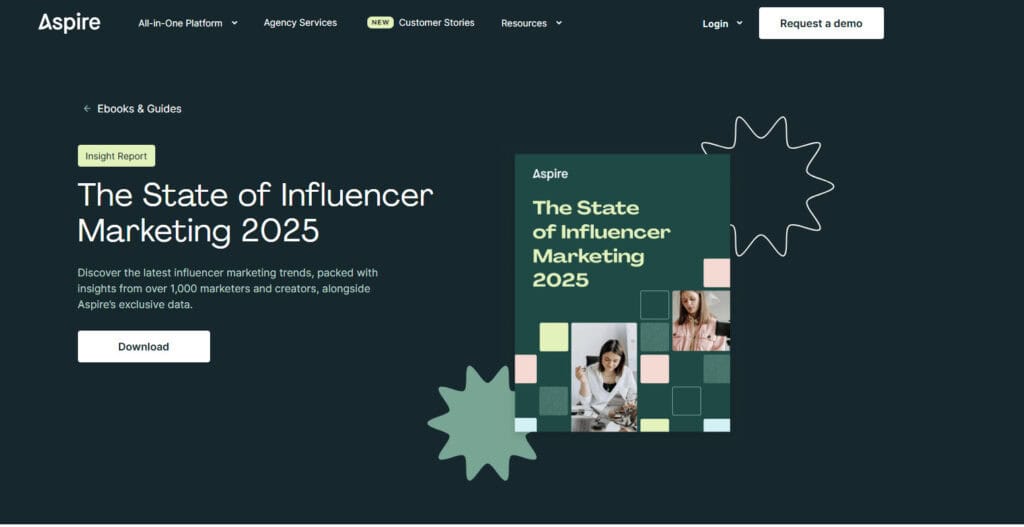
Why Aspire Is Great for Quick Finds:
- Super Easy Search Filters: You can filter influencers by the exact criteria you care about—like audience size, location, and engagement rate—so you don’t waste time sifting through irrelevant profiles.
- Clear Influencer Profiles: Each profile has tons of details—audience stats, engagement rates, past collaborations, and more—so you know exactly what you’re getting before reaching out.
- Campaign Tracking: Once you’ve found influencers, Aspire makes it easy to keep track of everything from start to finish—whether you’re handling one campaign or many.
Example: Let’s say you’re launching a new skincare product and need influencers with a proven interest in beauty. With Aspire, you could filter by “skincare,” 50K-200K followers, and a minimum 3% engagement rate to find the perfect fit in minutes.
2. Best for Performance-Based Campaigns: Grin
If you’re looking for more than just a one-time post and want to build long-term, performance-driven relationships, Grin is the platform to check out. It’s all about helping brands track sales, conversions, and ROI from their influencer campaigns, making it perfect for eCommerce businesses.
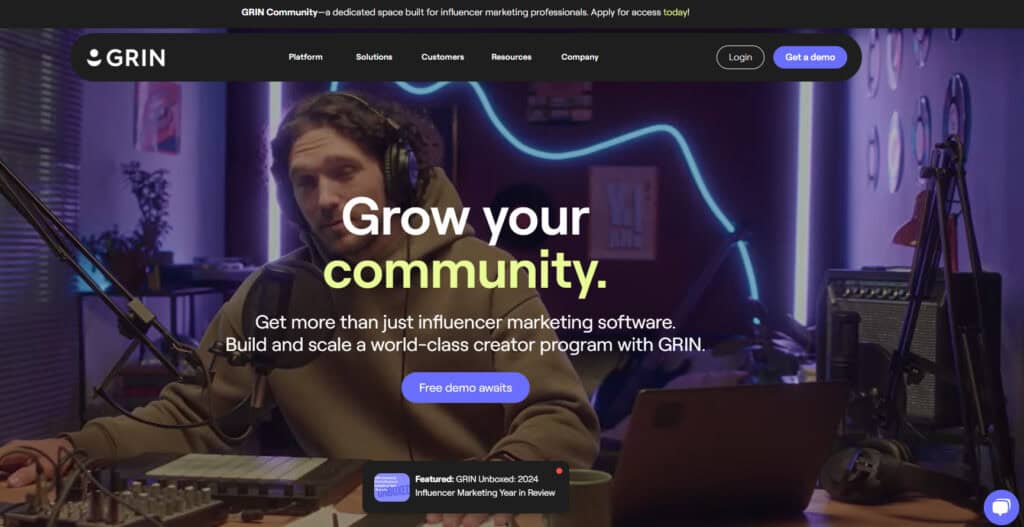
Why Grin Works for Performance-Based Campaigns:
- Trackable Affiliate Links: You can track how much traffic or sales each influencer drives to your site, so you know exactly how much they’re contributing to your bottom line.
- Manage Influencer Relationships: Grin helps you manage ongoing partnerships, not just one-off campaigns. Keep track of contracts, communication, and campaign milestones all in one place.
- Custom Workflows: Set up workflows that fit how you work with influencers. Approvals, content, deadlines—everything can be managed seamlessly.
3. Best for Small Businesses: Trend
For small businesses or startups, Trend is an excellent option. It connects you with micro-influencers (those with smaller but highly engaged followings) and allows for more budget-friendly partnerships, often involving free products or small fees.
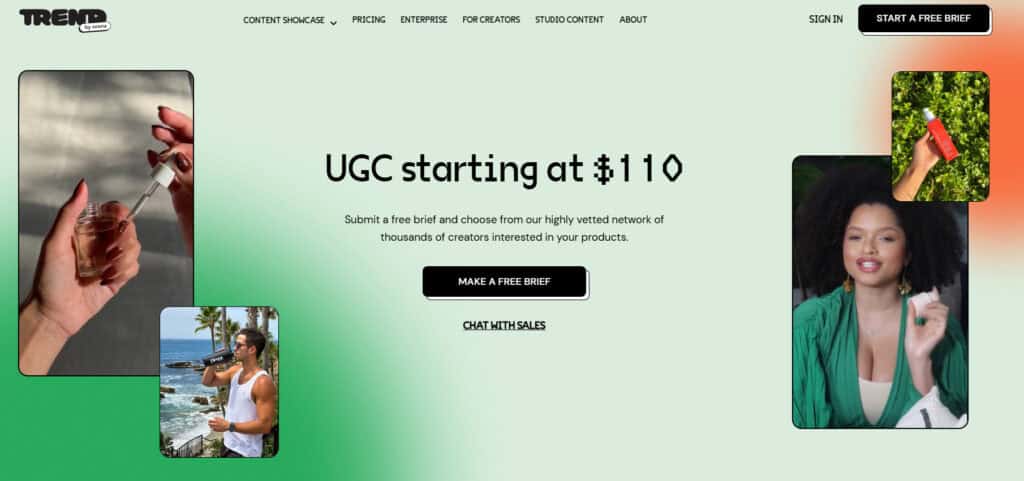
Why Trend Works for Small Businesses:
- Low-Cost Collaborations: You don’t have to spend big money. Most collaborations are based on gifting free products, making it accessible for smaller brands.
- Focus on Micro-Influencers: Trend’s focus is on influencers with smaller followings (usually under 50K), who often have more loyal and engaged audiences, which can be a great fit for niche products.
- Easy Analytics: While the platform isn’t overly complicated, it gives you enough data to track how your campaign is performing, from engagement to reach.
Example: Let’s say you have a small organic snack company. You could send samples to micro-influencers who are willing to share posts on Instagram in exchange. It’s a low-cost way to get the word out to potential customers who trust their influencer’s recommendations.
4. Best for Amazon Sellers: Levanta
This one is for the Amazon sellers who think that maybe influencer marketing is not even for them: Levanta. Unlike platforms that focus on a wide variety of industries, Levanta is built specifically for Amazon sellers. It helps you get more eyes on your Amazon listings and can improve your product’s ranking through influencer partnerships. And, guess what? It even lets you set up affiliate programs so you don’t have to invest upfront.
Why Levanta Is Ideal for Amazon Sellers:
- Amazon-Specific Integration: Levanta connects directly with Amazon, which means you can track how influencer promotions affect your product rankings and sales.
- E-commerce-Focused Influencers: The platform helps you find influencers who have a track record of driving traffic to Amazon, so you know you’re working with people who understand the platform.
- Campaign Performance Insights: Levanta lets you track the performance of each campaign, helping you understand how influencer partnerships are impacting sales and visibility.
- Longer Attribution Window: Levanta offers a 14-day attribution window—significantly longer than Creator Connections’ 24-hour window—giving you more time to capture and credit sales from creator-driven traffic.
- Direct Creator Access: With Levanta, you choose the creators who promote your products. Unlike Creator Connections, where Amazon makes the matches, you have full control over partnerships.
- Set Your Own Rates: Levanta puts you in control of your creator payouts. While Creator Connections lets Amazon decide what you pay, Levanta lets you determine the value of each promotion.
- Boost Organic Rankings with External Traffic: Sales driven through Levanta’s attribution links are recognized by Amazon as external traffic, which can significantly improve your organic search rankings.
- Earn More with the Brand Referral Bonus: On top of sales, Amazon rewards you with a 10% Brand Referral Bonus for purchases made through Levanta’s external links—stacking your growth and ROI.
Levanta assembled this report to help digital merchants navigate the new AI-shaped buying journey. Discover why creators now drive the clicks AI can’t and how to turn that into revenue.
5. Best for Influencer-Driven Content Creation: Upfluence
If you are trying to work with influencers to create high-quality content, then Upfluence should be on your radar. This platform is the best option out there for those brands that want influencers to produce long-term, engaging content, from Instagram posts to YouTube videos.
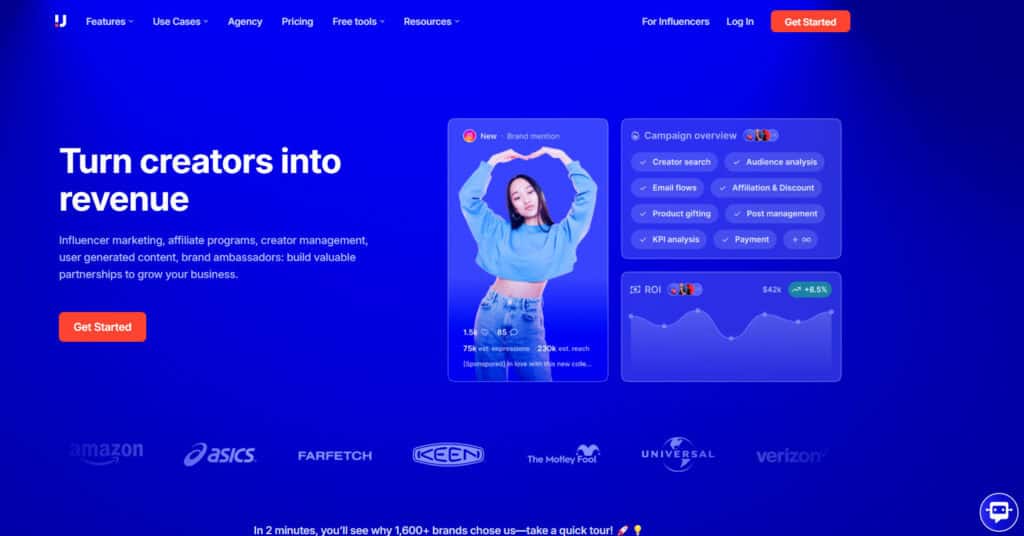
Why Upfluence Works for Content Creation:
- In-Depth Influencer Search: Upfluence’s search tools let you find influencers based on detailed criteria like audience type, engagement, and past content, so you can choose influencers who are a perfect fit for your brand.
- Collaboration Tools: Once you’ve selected an influencer, Upfluence makes it easy to collaborate on content creation, whether it’s co-authoring blog posts, crafting social media campaigns, or shooting videos.
- Performance Analytics: After the content is live, Upfluence tracks how it performs by looking at metrics like reach, clicks, and conversions.
How to Choose the Right Influencer Marketing Platform
Now you have a lot of options and a better idea of what each of them can do for you. All you need to do now is choose one:
1. Define Your Goal
Make sure you have your goals as clear as possible before even signing up for any demo. And, if you can, go beyond something generic like “I want more followers”. For example, if you are trying to build brand awareness, you will need a huge campaign, so you should focus on platforms with a massive influencer database. On the other hand, if you are focusing on sales, there are some performance-based platforms like Grin or Levanta that help you set up collaborations based on how much influencers can sell for you specifically.
2. Consider Your Budget
Not all platforms come with the same price tag, and you want to find something you can afford without struggling. Don’t go for one of the fancy, all-in-one platforms if you are just starting (you will probably use just 15% of their features anyway). If you’re a small business, you can go for affordable or commission-based options. If you find any free trials, make the most out of them.
3. Know Your Target Audience

Your audience should guide your choice. If you’re marketing to Gen Z, you will need an influencer marketing platform that can help you build a strategy on TikTok and Instagram. However, if your audience is more business-oriented, you might need a platform that supports LinkedIn influencer campaigns.
4. Decide How Much Automation You Need
Do you want a hands-on approach that needs your own input on every little detail, or do you prefer automation? Some platforms use AI to match brands with influencers and automate reporting, while others keep it old-school and provide more manual control. If you want a completely automated solution, choose a tool that handles influencer discovery, messaging, and performance tracking for you. If you are not an AI fan, then avoid those highly automated options and go for a simpler one.
5. Look for Multi-Channel Support
If you’re running influencer campaigns across multiple social platforms, make sure your tool can keep up. Some platforms focus on just one network, while others let you manage influencers across Instagram, YouTube, TikTok, and more, all in one place.
Final thoughts
Influencer marketing is always changing, and a good platform should help you keep up. Look for one that lets you test new ideas, track trends, and adjust your strategy as needed.
Most importantly, choose a platform that fits how you work. If you’re running small campaigns, you don’t need a complex system built for massive teams. If you’re scaling up, automation can save you time. The best platform isn’t the most expensive or the most advanced—it’s the one that makes influencer marketing feel simple and effective.


